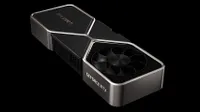GeForce RTX 3080 Ti Hits Best Buy At $1,199 MSRP
Nvidia just announced the GeForce RTX 3080 Ti a couple hours ago, and Best Buy didn't waste any time listing the new Ampere graphics card on its online store. In a time where stock is close to zero and we're used to seeing ludicrous pricing, seeing a graphics card at its MSRP is a rare sight. The GeForce RTX 3080 Ti goes on sale on June 3 and, as always, we expect all hell to break loose.
The GeForce RTX 3080 Ti fills in the gap between the GeForce RTX 3080 and GeForce RTX 3090, in regards to both pricing and performance. More importantly, the graphics card takes the fight to AMD's Radeon RX 6900 XT, which has a $999 MSRP before any Best Buy coupons. Nvidia specced the GeForce RTX 3080 Ti as close as possible to the GeForce RTX 3090 without cannabalizing the latter.
Fused with the same GA102 silicon, the GeForce RTX 3080 Ti comes with two disabled Streaming Multiprocessors (SMs) in comparison to the GeForce RTX 3090. That's less than a 3% difference in regards to the CUDA count between the two Ampere siblings. The margin should be almost negligible in the real world, and it just goes to show that Nvidia is a smart surgeon.
GeForce RTX 3080 Ti: $1,199.99 @ Best Buy
The GeForce RTX 3080 Ti arrives with 10,240 CUDA cores and 12GB of high-speed GDDR6X memory. The Ampere graphics card's performance is expected to be in the same alley as the flagship GeForce RTX 3090.
Nvidia had to make some sacrifices to the GeForce RTX 3080 Ti's memory system to knock the MSRP down to $1,199, $300 cheaper than the GeForce RTX 3090. While the GeForce RTX 3080 Ti retains the 384-bit memory interface, the graphics card arrives with half the amount of memory in comparison to the GeForce RTX 3090. The memory is clocked slightly lower as well. The compromises aren't as serious as they sound, though. At the end of the day, the difference in memory bandwidth between the GeForce RTX 3080 Ti and GeForce RTX 3090 is under 3%.
The GeForce RTX 3080 Ti makes more sense as a gaming graphics card than the GeForce RTX 3090. While modern titles are demanding more and more memory, especially at the higher resolutions, 12GB should suffice for a while. The GeForce RTX 3090's 24GB of GDDR6X memory is overkill outside of professional workloads.
The reviews for the GeForce RTX 3080 Ti aren't out yet, but if the specifications are any indication of performance, the graphics card will sell better than the GeForce RTX 3090. The Founders Edition will be the best bet for budget-conscious consumers that want a GeForce RTX 3080 Ti at MSRP since custom GeForce RTX 3080 Ti designs will probably carry a hefty premium.
Since Best Buy is Nvidia's official partner for Founders Edition cards, we expect it to stick with the $1,199 pricing. The real problem will be meeting demand, which will inevitably eclipse supply and then some, just as it has with every other GPU launched in the past nine months. Good luck!
Get Tom's Hardware's best news and in-depth reviews, straight to your inbox.

Zhiye Liu is a news editor, memory reviewer, and SSD tester at Tom’s Hardware. Although he loves everything that’s hardware, he has a soft spot for CPUs, GPUs, and RAM.
-
spongiemaster Why did the guy from Nvidia that was giving this presentation keep pronouncing "Ti" like "tie" instead of "tea eye?" I've never heard it pronounced like that in any previous Nvidia presentation.Reply -
Fates_Demise Reply
Because TI, is short for titanium, it's actual name is 3080 titanium, so he was probably just sounding out the start and hacking off the end.spongiemaster said:Why did the guy from Nvidia that was giving this presentation keep pronouncing "Ti" like "tie" instead of "tea eye?" I've never heard it pronounced like that in any previous Nvidia presentation. -
excalibur1814 ReplyTom Sunday said:... with up to 32-38 inches being now the new gaming norm and immersion talk.
Yeah, no.
Steam Hardware Survey continues to not surprise with results."One of those stats is that 1080P is the most used resolution among those that use Steam with a 34.72% share. The next most used resolution is 1366x768 with a 26.61% slice of the pie. Why such 'low' resolutions? That's actually likely due to a number of different factors, the more probable being that Steam is installed frequently on laptops with low resolution screens.
To further add evidence to such a theory, the Intel HD 4000 is still the most popular GPU that's reported by Steam. It comprises 6.32% of the user-base, with the GTX 970 trailing at 3.85%. Again, that could mean that it's reported by all Sandy Bridge CPU's as being installed, but could also, again, the result people using laptops for gaming. " -
helper800 Reply
I would argue that not even this is close to representative considering most "gaming" is done on phones and most phone resolutions are decently high, higher than 1080p.excalibur1814 said:Yeah, no.
Steam Hardware Survey continues to not surprise with results."One of those stats is that 1080P is the most used resolution among those that use Steam with a 34.72% share. The next most used resolution is 1366x768 with a 26.61% slice of the pie. Why such 'low' resolutions? That's actually likely due to a number of different factors, the more probable being that Steam is installed frequently on laptops with low resolution screens.
To further add evidence to such a theory, the Intel HD 4000 is still the most popular GPU that's reported by Steam. It comprises 6.32% of the user-base, with the GTX 970 trailing at 3.85%. Again, that could mean that it's reported by all Sandy Bridge CPU's as being installed, but could also, again, the result people using laptops for gaming. "
